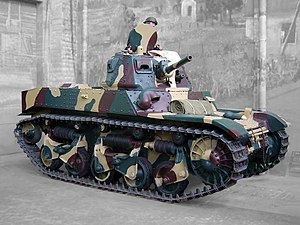AMC 35
| AMC-35 | |
|---|---|

AMC 35 in the Saumur tank museum |
|
| General properties | |
| crew | 3 (commander, driver, gunner) |
| length | 4.57 m |
| width | 2.24 m |
| height | 2.34 m |
| Dimensions | 14 t |
| Armor and armament | |
| Armor | Max. 25 mm |
| Main armament | 47 mm cannon, later 25 mm tank cannon |
| Secondary armament | 1 × 7.5 mm machine gun |
| agility | |
| drive | 4-cylinder petrol engine 180 hp |
| suspension | Coil suspension |
| Top speed | 40 km / h |
| Power / weight | |
| Range | 160 km |
The AMC 35 was a light main battle tank used by the French armed forces before, during and after World War II . Except for the engine power, it was on a par with the German Panzer III .
prehistory
In the years 1922/1923 a new reconnaissance vehicle was called for, which should be more off-road and faster than the vehicles used in the First World War. After its completion, the prototype was named "Auto Mitrailleuse de Cavalerie". Afterwards, a number of vehicle types were tested without much success until 1931 the demand for three different cavalry vehicles was made:
- Découverte = discovery;
- Combat = fight;
- Reconnaissance = enlightenment
- AMD "Auto Mitrailleuse de Découverte" (which corresponded to the Panhard 178 )
- AMC "Auto Mitrailleuse de Combat" (see AMC 35)
- AMR "Auto Mitrailleuse de Reconnaisance"
production
Renault built a first prototype in 1933 to meet the required classification according to an AMC (Auto-Mitrailleuse de Combat) (such as "self-propelled combat machine gun"; see also Mitrailleuse - a synonym for machine gun in French-speaking countries ), although this designation does not corresponded to actual conditions, as it had all the necessary characteristics of a main battle tank. The expectations placed on the vehicle could not be met during testing, so that a second prototype with a pilot series of twelve had to be produced under the designation " AMC 34 Renault YR". These vehicles were originally fitted with the turret of the Renault FT (fitted with a 37 mm cannon ); this was later replaced by the APX-2 turret. It was already a two-man turret, which made the task much easier for the commander, as he did not also have to operate the cannon. The armament of this vehicle initially consisted of a 47 mm cannon and a 7.5 mm machine gun installed parallel to the axis, and later a 25 mm cannon. However, this tank no longer met the requirements of the tender.
Renault now built a new vehicle, the Renault ACG. Although this type also did not meet the requirements (neither maximum speed, nor armor nor mechanical reliability), it was approved as AMC 35 . The main difference from the AMC-34 was the shortened hull, which made it possible to accommodate a smaller version of the Char B1 's engine . The tower was operated by two men, which made the duties of the commander much easier. In the turret, 250 rounds for the 25 mm main gun could be carried. However, production of the vehicle started slowly. Twelve copies were delivered to Belgium. Although attempts were made to speed up production when the war broke out, it was already too late for that. A total of only 50 series vehicles of this type were produced by Renault and AMX by January 1940.
Other technical data
- Climbing ability: 0.61 m
- Trench crossing ability: 1.83 m
- Gradeability: 60%
- Production quantity: 50 pieces
- Running gear: five rollers with coil springs, front drive wheel, five support rollers
In use from 1935 to 1940
In 1937 twelve vehicles were sold to Belgium and converted there, and three more in 1939. They were given a remodeled in Belgium tower with a 47-mm anti-tank gun and coaxial 13.2-mm machine gun. The tanks were called "Auto Mitrailleuse de Corps de Cavalerie" and assigned to the hunters on horseback (Chasseurs à Cheval / Jagers te Paard). In battles against German troops in May 1940 ( western campaign ), four of eight tanks that were still operational were destroyed by PaK .
All of the French AMC-35 tanks were not operational when the fighting began in May 1940. A few vehicles were provisionally made ready for combat, but disappointed in use, especially because of the short range in the field and because of technical defects.
After the defeat of France in 1940 , the Germans took over the vehicles that were still usable and incorporated them into the Wehrmacht under the designation PzKpfw AMC 738 (b) or (f) . They were used by the German occupation forces for security tasks. → see also booty tanks
literature
- Tanks and other combat vehicles from 1916 to the present day. Buch und Zeit Verlagsgesellschaft, Cologne 1977.
- Tank models from around the world from 1915 to today. Parragon Books, Bath, ISBN 978-1-4075-0670-8 , p. 70.
